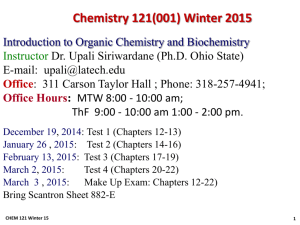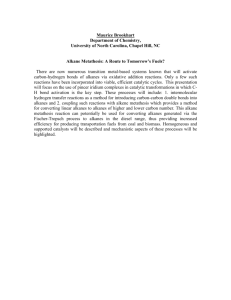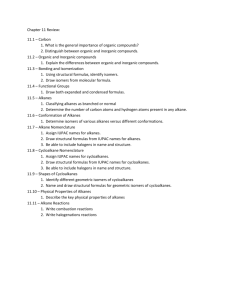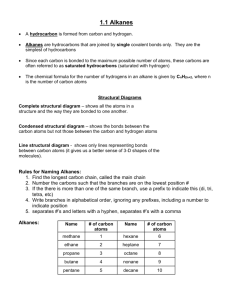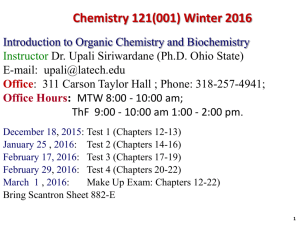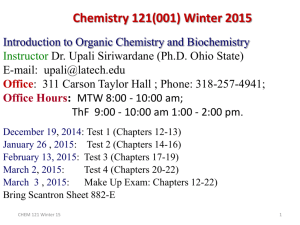GHW#1-Questions
advertisement
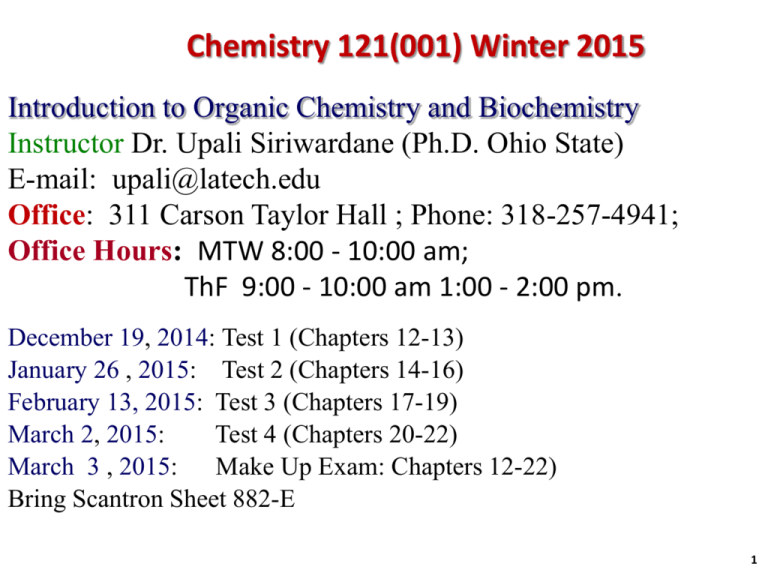
Chemistry 121(001) Winter 2015 Introduction to Organic Chemistry and Biochemistry Instructor Dr. Upali Siriwardane (Ph.D. Ohio State) E-mail: upali@latech.edu Office: 311 Carson Taylor Hall ; Phone: 318-257-4941; Office Hours: MTW 8:00 - 10:00 am; ThF 9:00 - 10:00 am 1:00 - 2:00 pm. December 19, 2014: Test 1 (Chapters 12-13) January 26 , 2015: Test 2 (Chapters 14-16) February 13, 2015: Test 3 (Chapters 17-19) March 2, 2015: Test 4 (Chapters 20-22) March 3 , 2015: Make Up Exam: Chapters 12-22) Bring Scantron Sheet 882-E 1 Slides & GHW Questions GHW#1 2 Chapter 12. Saturated Hydrocarbons 12.1 Organic and Inorganic Compounds, 341 12.2 Bonding Characteristics of the Carbon Atom, 342 12.3 Hydrocarbons and Hydrocarbon Derivatives, 342 12.4 Alkanes: Acyclic Saturated Hydrocarbons, 343 12.5 Structural Formulas, 344 12.6 Alkane Isomerism, 346 12.7 Conformations of Alkanes, 348 12.8 IUPAC Nomenclature for Alkanes, 350 12.9 Line-Angle Structural Formulas for Alkanes, 356 12.10 Classification of Carbon Atoms, 358 12.11 Branched-Chain Alkyl Groups, 359 12.12 Cycloalkanes, 361 12.13 IUPAC Nomenclature for Cycloalkanes, 362 12.14 Isomerism in Cycloalkanes, 363 12.15 Sources of Alkanes and Cycloalkanes, 365 12.16 Physical Properties of Alkanes and Cycloalkanes, 367 12.17 Chemical Properties of Alkanes and Cycloalkanes, 368 12.18 Halogenated Alkanes and Cycloalkanes, 371 1. Circle the correct compound type (ionic or covalent) for the following: formula compound type a) NBr3 (ionic or covalent) b) NaCl (ionic or covalent) c) C2H5OH (inorganic or organic) d) NH4NO3 (inorganic or organic) CHEM 121 Winter 2013 4 Shapes of Atomic Orbitals – A s orbital consists of sphere with the center at the nucleus – A p orbital consists of two lobes arranged in a straight line with the center at the nucleus Shapes of p Atomic Orbitals – A p orbital consists of two lobes arranged in a straight line with the center at the nucleus Hybridizations of Atomic Orbitals – sp3 tetrahedral 108.9 – sp2 trigonal planar 120 – sp linear 180 Electronic Configuration of atoms Ground state electronic configuration of atoms in core format Carbon (C): [He] 2s2, 2p2 or [He] 2s2, 2px13py13pz0 Potassium (K): [Ar] 4s1 Phosphorous (P): [Ne] 3s2, 3p3 Valence shell electronic configuration Carbon (C): 3s2, 3p2 Potassium (K): 4s1 Phosphorous (P): 3s2, 3p3 How you get the electronic configuration of an atom from the periodic table? 2.For the atoms and ions below, circle the correct ground state valence electron configuration of carbon in core format: a) Carbon (C): 2s2, 2px12py12pz1 b) Carbon (C): 4s1 or 3s2, 3p6 c) Carbon (C): [Ne] 3s2, 3p3 d) Carbon (C): [He] 2s2, 2px12py12pz0 CHEM 121 Winter 2013 9 Lewis structure of atoms (Review) 3. Circle the Lewis structures of the following atoms: a) N b) C CHEM 121 Winter 2013 11 Drawing Lewis structure molecules and ions (Review) 1) Add all valence electron of atoms in the molecule from the formula. 2) Add the ion charge for negative ions or subtract for positive ions. 3) Draw the skeletal structure by connecting the atoms with single bonds. 4) Give each of the atoms an octet (8 e-). Adding unshared pairs of electrons 5) Count the total number of e- used through step 4 and compare to the number calculated in 4. Circle the correct Lewis structure for following compounds: a) CH3OH CHEM 121 Winter 2013 13 Electronegativities of Elements Electronegativity The ability of one atom in a molecule to attract electrons to itself. H-O-H Classify following bonds nonpolar-covalent, polar-covalent or ionic bonds N-H 3.0 and 2.1 = 0.9 O-H 3.5 and 2.1 = 1.4 C-H 2.5 and 2.1 = 0.4 C-F 2.5 and 4.0 = 2.5 Na-Cl 0.9 and 3.0 = 2.1 Al-Cl 1.5 and 3.0 = 1.5 Pure Covalent: 0-0.4 Polar Covalent: 0.5-1.5 Ionic Bond: <1.5 5. Circle the most polar bond in the following molecule : CHEM 121 Winter 2013 16 Classifying Organic Compounds Examples Functional Group Ending Hydrocarbons C and H only Alcohols R-OH Acids R-COOH Amines R-NH2 Ketones R(C=O)R’ Aldehydes R-CHO -ane -ol -oic acid -amine -one -al Types of formula for organic compounds Chemical formula: Indicate the kind and number of each type of atom in the molecule. Condensed formula: Shows skeletal atoms in a molecule and places them in a sequential order that indicates bonding. Structural formula: Shows each atom and bonds in a molecule. Line-angle formula: The hydrogen atoms are removed from carbon chains, leaving just a carbon line skeleton with functional groups attached to it. Alicyclic Alkanes Are saturated hydrocarbons: Noncyclic alkanes: General molecular formula, CnH2n+2 Structural formula: 6. Name the functional group in each of the following molecules CHEM 121 Winter 2013 20 7) Give the formulas for each of the following: a) i) Molecular formula: ii) Condensed formula: CHEM 121 Winter 2013 21 7) Give the formulas for each of the following: b) i) Molecular formula: ii) Condensed formula: iii) Line-angle formula: b)b CHEM 121 Winter 2013 22 8) Give the following for an straight alkane with five carbons atoms i) Molecular formula: ii) Condensed formula: iii) Line-angel formula: iv) IUPAC name: CHEM 121 Winter 2013 23 Nomenclature: Unbranched or straight chain alkanes General molecular formula: CnH2n+2 All bond angles about tetrahedral carbon are approximately 109.5° N ame Molecular Formula methane CH4 ethan e C2 H6 propane C3 H8 bu tane C4 H1 0 pen tane C5 H1 2 hexan e C6 H1 4 hep tane C7 H1 6 octane CHEM 121 Winter 2013 N ame Molecular Formula nonane C9 H2 0 decan e C1 0 H2 2 dodecan e C1 2 H2 6 tetrad ecane C1 4 H3 0 hexadecane C1 6 H3 4 octadecan e C1 8 H3 8 eicosane C2 0 H4 2 C8 H1 8 24 Nomenclature: Unbranched or straight chain alkanes General molecular formula: CnH2n+2 All bond angles about tetrahedral carbon are approximately 109.5° N ame Molecular Formula methane CH4 ethan e C2 H6 propane C3 H8 bu tane C4 H1 0 pen tane C5 H1 2 hexan e C6 H1 4 hep tane C7 H1 6 octane C8 H1 8 N ame Molecular Formula nonane C9 H2 0 decan e C1 0 H2 2 dodecan e C1 2 H2 6 tetrad ecane C1 4 H3 0 hexadecane C1 6 H3 4 octadecan e C1 8 H3 8 eicosane C2 0 H4 2 Rules of IUPAC Nomenclature of Branched Alkanes Parent name: the longest carbon chain Substituent: a group bonded to the parent chain Alkyl group: a substituent derived by removal of a hydrogen from an alkane; given the symbol R- written in alphabetical order CH4 becomes CH3- (methyl) CH3CH3 becomes CH3CH2- (ethyl) Prefixes: di-, tri-, tetra-, etc. are not included in alphabetization Common alkyl groups N ame methyl Con dens ed Structu ral Formula -CH3 ethyl -CH2 CH3 propyl -CH2 CH2 CH3 isopropyl -CHCH3 CH3 bu tyl -CH2 CH2 CH2 CH3 N ame isobu tyl sec-butyl Con dens ed Structu ral Formula -CH2 CHCH3 CH3 -CHCH2 CH3 CH3 CH3 t ert-bu tyl -CCH3 CH3 9) IUPAC name of the following branched alkane: CHEM 121 Winter 2013 28 10) Give the names of following alkyl groups: CHEM 121 Winter 2013 29



